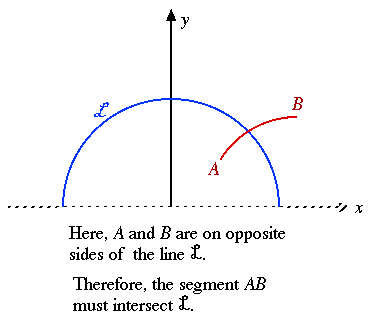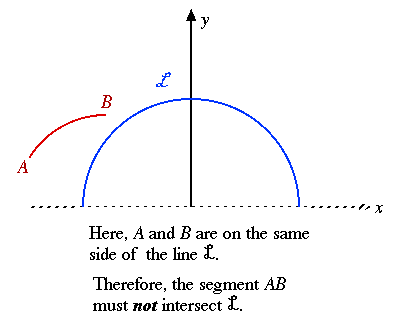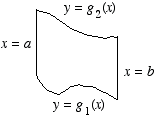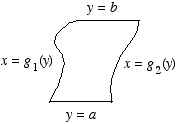Hint for exercise #44 in §7.9
Sometimes there's more than one way to organize the proof of an "if and only
if" statement. One way that works fairly well here is to prove the following
two statements:
- If the points A and B are
on opposite sides of the line L, then the segment
 intersects
L.
intersects
L.
- If the points A and B are
on the same side of the line L, then the segment
 does
not intersect L.
does
not intersect L.
Of course, the notation  refers to the Poincaré segment joining
A and B. If the two points happen to
have the same x-coordinate, then the Poincaré segment will
be the same as the corresponding Euclidean segment, but otherwise it will
be the a specific circular arc that has A and
B as its endpoints.
refers to the Poincaré segment joining
A and B. If the two points happen to
have the same x-coordinate, then the Poincaré segment will
be the same as the corresponding Euclidean segment, but otherwise it will
be the a specific circular arc that has A and
B as its endpoints.
I'll focus my comments mainly on the case where
L is a curved Poincaré line. Suppose that
that the equation of L is
(x -  )2
+ y2 =
)2
+ y2 =  2.
2.
Then one side of L is (by definition) given by the
inequality (x -  )2 + y2 -
)2 + y2 -  2 > 0, while the other side is given by
the opposite inequality. Now, we represent the segment
2 > 0, while the other side is given by
the opposite inequality. Now, we represent the segment
 parametrically. If
A and B have the same
x-coordinate, then this will be x = (constant),
y = t, for t in some specific
interval. If A and B have distinct
x-coordinates, then it will be a trigonometric parametrization with
the parameter, say t, running through some closed interval.
{But the center and radius that are involved likely will be different from
parametrically. If
A and B have the same
x-coordinate, then this will be x = (constant),
y = t, for t in some specific
interval. If A and B have distinct
x-coordinates, then it will be a trigonometric parametrization with
the parameter, say t, running through some closed interval.
{But the center and radius that are involved likely will be different from
 and
and
 .}
.}
Anyway, we substitute from the parametrization
to express (x -  )2 + y2 -
)2 + y2 -  2 > 0, as a function of the parameter t on
the appropriate interval. If things are set up correctly, then in proving
the first statement, you'll find that this quantity is positive at one end of
the interval and negative at the other endpoint, and is a continuous function
of the parameter t. So, we have a setup where we can apply
the Intermediate Value Theorem.
2 > 0, as a function of the parameter t on
the appropriate interval. If things are set up correctly, then in proving
the first statement, you'll find that this quantity is positive at one end of
the interval and negative at the other endpoint, and is a continuous function
of the parameter t. So, we have a setup where we can apply
the Intermediate Value Theorem.
For proving the second statement, things are slightly
more delicate. We'll find that our function (the same one as in the other
part) is either positive at both ends of the interval, or negative at both
ends of the interval. We'd like to claim that it's also nonzero at all other
points of the interval, but the Intermediate Value Theorem is of no help
whatsoever in this kind of situation. Instead, the strategy is to show that
the function is monotonic (either strictly increasing or strictly decreasing)
on the interval in question. We have to use the specific form of our
function, namely that it's obtained by substituting from our parametrization
into the expression x -  )2 + y2 -
)2 + y2 -  2. Alternatively, an
approach to establishing monotonicity without actually using parametrizations
seems to be the point of Lemma 3 in §7.3.
2. Alternatively, an
approach to establishing monotonicity without actually using parametrizations
seems to be the point of Lemma 3 in §7.3.
The following diagrams should give some
indication of what the basic concepts are about.



 =
=


 =
=
